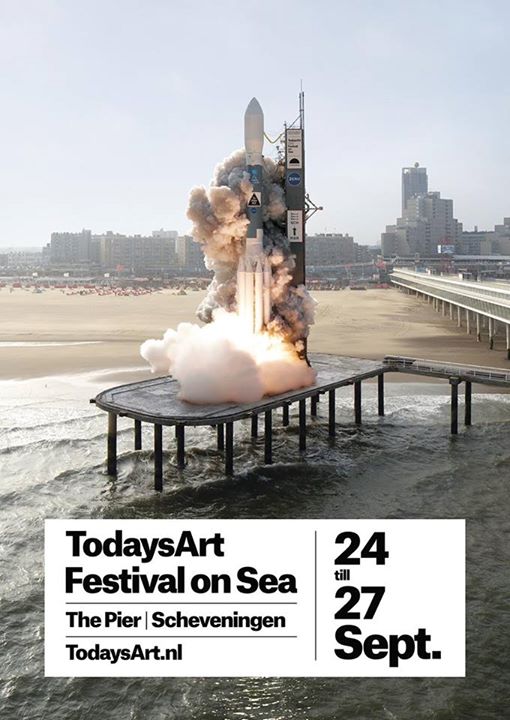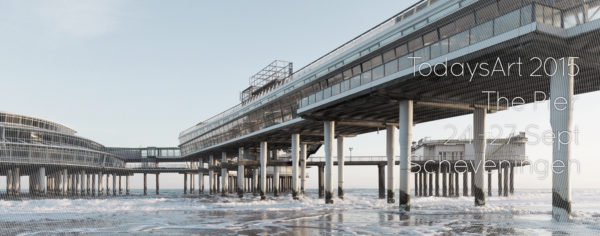TodaysArt is a platform organisation that revolves around the presentation and development of adventurous and contemporary visual and performing arts in urban environment. Since 2005, TodaysArt has brought local and international artists, thinkers and audiences together worldwide. TodaysArt is a stage for international talent and pioneers who explore new forms of expression. The organization’s main event TodaysArt.NL in The Hague has been organized since 2005. International editions of the festival are being organized by partner organizations and previously took place in Brussels (TodaysArt.BE in 2011) and Tokyo (TodaysArt.JP in 2014). This year, it takes place between 24 and 27 September 2015 at the Scheveningen Pier in the Hague, with several SHAPE artists performing. For more information, click here. Here we talk to festival organiser Tim Terpstra about the ins and outs of TodaysArt.
For most of our previous editions, we created a programme for appropriate – well-facilitated – venues around one of the main squares in The Hague’s city centre. We realised complex projects in public spaces as well, but our programming was on many levels well facilitated. Since 2013 TodaysArt has become more nomadic and we started utilising locations that have interesting features and possibilities on a social, political or urban level.
For the previous edition in 2014, we were already trying to get in contact with the real estate curator who was tasked with selling The Pier to new owners, but it was impossible to get in touch with him. This year, we tried again to collaborate with the new owners and succeeded.
We had to adapt our process even more to create a programme that really worked for The Pier. The building on the sea features many limitations and characteristics that are very unusual for a music and audiovisual arts event. More now than ever, the location determined the programme rather than the other way around.
This year forms a unique context since exactly 50 years ago, on the 25th of September 1965, a large scale multimedia open-air art manifestation was planned on The Pier by the radical and revolutionary art movement ZERO. This event never took place because of bad weather conditions and financial reasons. TodaysArt usually is hesitant to relate itself to historical contexts, but the ZERO movement is still very relevant today, maybe even more than ever. ZERO questioned the role of an artist, connected artists saw themselves also as curators, researchers and entrepreneurs. ZERO wanted to break with the established principles regarding what art should look like and envisioned strong links to society and its environment. They were inspired by natural elements and used new materials that had become available through technological progress. Inspired by ZERO on Sea, TodaysArt presents a festival in the same location with new generations of artists and makers.
Can you specify the projects that are tailor-made for the location?
Staalplaat Soundsystem will create ‘Zeero’, a very large organ of four steel tubes with a length of 24 metres and a diameter of 1.2 meters (usually used for sand depletion). Staalplaat will use hot air balloon burners to create sound.
The bungee jumping tower, which for us represents a more commercial activity at the pier, will be used by Mike Rijnierse for the site-specific work ‘Klok’. A church bell weighing around 100 kg attached to the bungee cord is dropped from the tower and creates a unique sound experience through the Doppler effect.
Natalie Jeremijenko will build a second Pier next to The Pier which achieves all the functions of a conventional pier, while reaching into the productive aspects of the aquatic ecosystem. It distills and desalinates water, promotes habitat for mussels and algae and the many organisms they support while improving water quality and biodiversity.
4DSOUND premieres their ‘Circadian’ program in the Electriciteitsfabriek – an interdisciplinary work from a diverse set of artists all created exclusively with and for 4DSOUND. The programme features Lisa Park, Marco Donnarumma, Kazuya Nagaya, Robert Jan Liethoff, Oscar Mulero, Cassegrain, Michelle Lewis-King and ‘Noqturnl’ by John Connell and Florence To. ‘Circadian’ investigates how spatial listening influences conscious states throughout the day and night. Performances explore how to physically connect the listener with the surrounding space through movement, bio-physical media and psycho-acoustic stimulation.
Would you say that also ideologically what the ZERO movement wanted to do back in the day and what you are trying to do now is similar?
What we are trying to achieve with these events, similarly to what they were doing, is try to place art in a way that interacts with society in a way that corresponds to what we are trying to achieve with the festival to not only be a festival for the niche, but also reach an audience which is just passing by.
There’s another aspect of ZERO that is really relevant. We’re also focusing on the relationship between art, technology, nature and humans which I think has become even more important nowadays, a lot of artists are experimenting and using technology to improve their work in terms of quality, reach, meaning and application.
A lot of the new media festivals were focused on the future and futurism as such, and your name implies that it tries to reflect the present and represent that in what you do.
We never finish the programme until a week before the festival. If you want to present what is actually happening at this moment, you have to remain flexible without ignoring the past or the future. We’re not a festival focused on the future, but we never avoid ideas that deal with future scenarios.
What would you say is the social perspective of TodaysArt? Is the community aspect or responsibility towards society at large important?
I think the community aspect is one of the primary elements of any independent festival. We are a publicly funded festival and it’s really important to inspire people and give them experiences that inspire them too to look at the world differently. The threshold of the festival becomes really low, people participate, we do free events which people can attend. It has always been important for us to connect to the local context.
For example now with The Pier, we are also working on a project that involves surf culture because we are basically in the habitat of the surfers and I think a lot of festivals would not involve something that would at first seem so distant from what they’re doing. We are working with them to develop a project with LED lighting – creating light compositions at night. For me this is the perfect way in which local context and communities are integrated into this festival, which in other cases might be ignored. We are also creating a Bright Collisions symposium programme each year, which is more discoursive around the themes we are discussing and contributing to the general discussions.
Can you talk about the various international editions that you have?
The September month is a bit intense for us this year. The festival in Japan is planned in two cities, Tokyo and Kobe, from the 5th until the 23rd of September. In October there will be another chapter of the TodaysArt.JP festival in Kawasaki. Besides that there’s an exhibition in Moscow in October. All TodaysArt events use its concept but are fully locally produced, which we think is essential to make it work.
Do the cultural differences change the experience of the festival?
There seems to be quite a big need in Japan for the merging of different disciplines, both in production as well as in presentation. Electronic music is presented in clubs, concerts in concert halls, art in galleries and museums, etc. What TodaysArt.JP aims to do is free these disciplines, much more connected to the type of art and music that is currently being created. Art in a public space has a lot of potential in Japan. Politically relating to actualities can be much more sensitive in Japan compared to the Netherlands.
What about Russia, has politics somehow influenced your modus operandi there?
For now, we’ve been lucky not to be too involved directly in politics. We’ve had a lot of questions, especially looking at international relations, but also relations between the Netherlands and Russia, asking why we are doing stuff in Russia and why are we not participating in this boycott of arts and culture there. Our standpoint has never changed though, you do not do this for politics, you do it for the people and artists. The economy changed in Europe and Russia and it slowed down our activities a bit, so sometimes it’s more often the economy rather than politics that influences the activities.
What represents today’s art these days? What is the relevant art of today?
Today, especially in this world which is becoming increasingly complex and troubled, art becomes a way of questioning our world and also posing questions which could really make us look at the world differently and sometimes even inspire people to be able to change it.
And what are your personal motivations for doing TodaysArt?
What I really like about TodaysArt, and what I haven’t experienced as much in other environments, is that artists are allowed to experiment. The festival is a laboratory. It’s really important that artists have the opportunity to be in an environment where they can experiment in front of an audience. It doesn’t always need to be a 100 percent success, it can be a failure.

